
Eriophyllum lanatum, with the common names common woolly sunflower and Oregon sunshine, is a common, widespread, North American plant in the family Asteraceae.

Hulsea algida is a species of flowering plant in the daisy family, known by the common name Pacific hulsea or alpine gold.
Antennaria geyeri is a North American species of flowering plant in the family Asteraceae known by the common name pinewoods pussytoes or mountain pussytoes. It is native to the western United States where it grows in woodland and scrub very often on the forest floor under pine trees. It is found in Washington, Oregon, northern California, and northwestern Nevada.
Calycadenia mollis is a species of flowering plant in the family Asteraceae known by the common name soft western rosinweed. It is native to a section of central California, from Tuolumne County do northern Tulare County. There are also isolated populations farther north in Nevada County. The plant grows in a number of habitat types in the Central Valley and adjacent Sierra Nevada foothills.
Chaenactis alpigena is a species of flowering plant in the daisy family known by the common name southern Sierra pincushion. It is native to the High Sierra Nevada and the White Mountains of California, extending in the latter just into Nevada.
Chaenactis santolinoides is a California species of flowering plant in the daisy family known by the common name Santolina pincushion.
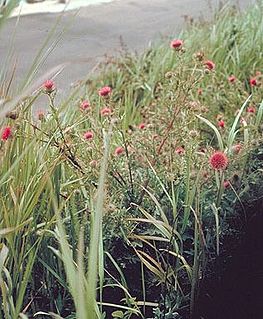
Cirsium andrewsii is an uncommon species of thistle known by the common name Franciscan thistle. It is endemic to California, where it is known from the coastline of the San Francisco Bay Area from Marin to San Mateo Counties. There are also reports of isolated populations in the Klamath Mountains and in the Sierra Nevada.

Encelia actoni, also known by the common names Acton brittlebush and Acton encelia, is a species of flowering plant in the family Asteraceae.
Hosackia incana, synonym Lotus incanus, is a species of legume native to California. It is known by the common name woolly bird's-foot trefoil. It is endemic to the Sierra Nevada of California, where it grows in forests and other mountain habitat.

Eriodictyon lobbii is a species of flowering plant in the borage family known by the common names Lobb's fiddleleaf and matted yerba santa. It is native to the Sierra Nevada and southern Cascade Range chain in California and adjacent sections of Nevada and Oregon. It grows in high mountain habitat in dry areas on slopes and ridges.
Pseudobahia bahiifolia is a rare species of flowering plant in the family Asteraceae known by the common name Hartweg's golden sunburst.

Raillardella argentea is a species of flowering plant in the family Asteraceae known by the common name silky raillardella. It is native to the Sierra Nevada and nearby mountain ranges of California, its distribution extending east into Nevada and north along the Cascade Range and Klamath Mountains into Oregon. It grows in many types of dry, open mountain habitat. It is a rhizomatous perennial herb growing in a clump of rosetted basal leaves. The leaves are lance-shaped, up to 8 centimeters long, and coated in silky hairs. The plant produces an inflorescence up to about 15 centimeters tall consisting of a solitary flower head which is cylindrical to somewhat bell-shaped. The head is enclosed in the fused outer scales of the flowers, which look similar to the phyllaries of many other species' flower heads. The head contains many yellow disc florets up to a centimeter long each, and no ray florets. The fruit is a long, narrow achene which may be 2 centimeters in length including its plumelike pappus.

Ribes roezlii is a North American species of currant known by the common name Sierra gooseberry.
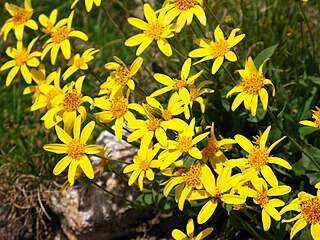
Packera werneriifolia, known by the common names alpine rock butterweed and hoary groundsel, is a species of flowering plant in the aster family. It is native to the western United States in the Sierra Nevada mountain habitat in subalpine and alpine climates, including forests and barren talus.
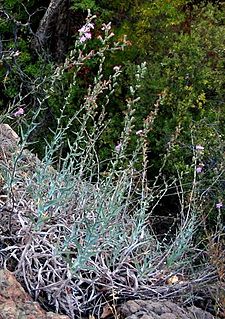
Stephanomeria cichoriacea is a species of flowering plant in the aster family; it is known by the common names chicoryleaf wirelettuce and silver rock-lettuce. It is endemic to California, where it grows in the coastal mountain ranges as far north as Monterey County, but especially in southern California mountains such as the Transverse Ranges. Its habitat includes chaparral. It is a perennial herb producing slender erect stems reaching maximum heights exceeding one meter. The stem is woolly with hairs, especially on new growth. The leaves are mostly located in a basal rosette, the largest reaching 18 to 20 centimeters long. They are lance-shaped and often toothed along the edges, and the newer ones are woolly. Smaller leaves occur farther up the stem. The inflorescence is a long array of several flower heads, with some occurring in the upper leaf axils as well. Each head has a cylindrical base 1 to 2 centimeters long which is lined with layers of glandular phyllaries. The head contains 10 to 15 ray florets, each with an elongated tube and a pink ligule which may be up to 2 centimeters long. The fruit is an achene tipped with a spreading cluster of long, plumelike pappus bristles.
Agnorhiza bolanderi is a species of flowering plant known by the common name Bolander's mule's ears. It is endemic to California, where it is known only from a narrow section of the Sierra Nevada foothills about 275 kilometers long from Shasta County to Mariposa County. It grows in chaparral and grassland habitat, usually on serpentine soils.
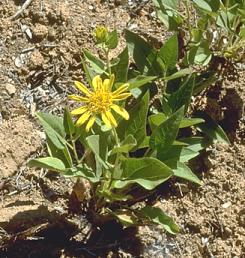
Agnorhiza reticulata, known by the common name El Dorado County mule's ears, is a rare species of flowering plant found only in a small region of north-central California.
Agnorhiza elata is a species of flowering plants known by the common name Hall's mule's ears. It is endemic to California, where it is known only from a section of the central Sierra Nevada foothills. It occurs primarily in a region stretching from Tuolumne County to Fresno County, but a few isolated populations have been found in Tulare County.

Agnorhiza ovata is a species of flowering plant known by the common name southern mule's ears. It is native to the mountains and foothills of southern California and Baja California, occurring the Coast Ranges and Sierra Nevada foothills in Tulare, Kern, Ventura, Los Angeles, Orange, Riverside, and San Diego counties in California, with additional populations in the Peninsular Ranges south of the international border.
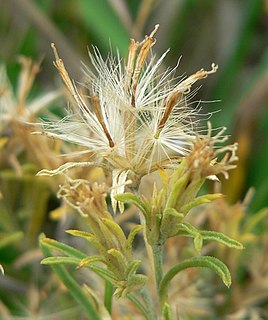
Ericameria parryi is a species of flowering plant in the aster family known by the common name Parry's rabbitbrush. It is native to much of the western United States.
















